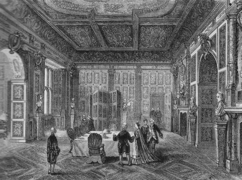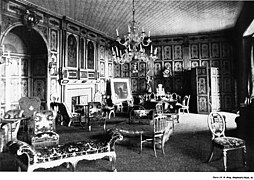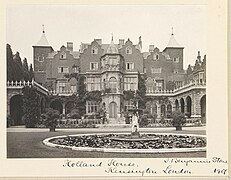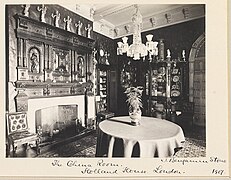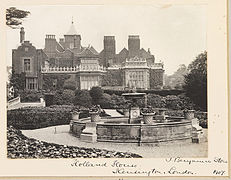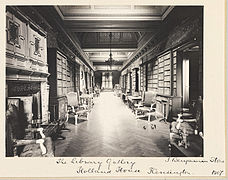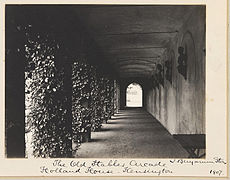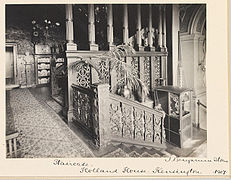Holland House
| Holland House | |
|---|---|
 Holland House in 1896 and its remains in 2014 | |
| Location | London |
| Coordinates | 51°30′9″N0°12′19″W/ 51.50250°N 0.20528°W |
| Built | 1605 |
| Built for | Sir Walter Cope |
| Architectural style(s) | Jacobean |
| Owner | Royal Borough of Kensington and Chelsea |
Listed Building– Grade I | |
| Designated | 29 Jul 1949[1] |
| Reference no. | 1267135 |
Holland House,originally known asCope Castle,was an earlyJacobeancountry houseinKensington,London,situated in a country estate that is nowHolland Park.It was built in 1605 by the diplomatSir Walter Cope.The building later passed by marriage toHenry Rich, 1st Baron Kensington, 1st Earl of Holland,and by descent through theRich family,then became the property of theFox family,during which time it became a noted gathering-place forWhigsin the 19th century. The house was largely destroyed by German firebombing duringthe Blitzin 1940 and today only the east wing and some ruins of the ground floor and south facade remain, along with various outbuildings and formal gardens. In 1949 the ruin was designated agrade I listedbuilding[1]and it is now owned by theRoyal Borough of Kensington and Chelsea.
17th century[edit]
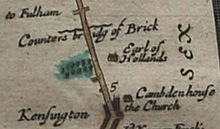
Cope commissioned the house in 1604 from the architectJohn Thorpe,[a]to preside over a 500 acres (200 ha; 0.78 sq mi) estate that, in modern terms, stretched fromHolland Park Avenuealmost toFulham Road,[3]and contained exotic trees imported byJohn Tradescant the Younger.[4]Following its completion, Cope entertained the king and queen at it numerous times; in 1608,John Chamberlain,the noted author of letters, complained that he "had the honour to see all, but touch nothing, not so much as a cherry, which arecharilypreserved for the queen's coming. "[5]
Cope was a cousin ofDudley Carleton,the English ambassador in Venice. The Venetian ambassador in London,Antonio Foscarini,cultivated Cope and visited his house in Kensington.[6]In November 1612King James I,following the death of his eldest sonHenry Frederick, Prince of Wales,spent the night at Cope Castle. He was joined the following day by his sonPrince Charlesand daughterPrincess Elizabeth,and her fiancéFrederick V, Elector Palatine.[7]
Cope died in 1614 without a son. The house was inherited by his daughter Isabel Cope, who in 1616, two years after her father's death, marriedHenry Rich, 1st Earl of Holland,whose property it then became. Rich was granted the titles ofBaron KensingtonandEarl of Hollandby James I, and upon gaining the latter renamed the building to Holland House.[8]In 1649 Rich was beheaded for hisCavalieractivities during theEnglish Civil Warand the house was then used as an army headquarters, being regularly visited byOliver Cromwell.
Following the death of Henry Rich, his eldest son Robert Rich, the second Earl of Holland, inherited the house, and in 1673 succeeded his first cousin as fifthEarl of Warwick,which is commemorated locally by Warwick Road and Warwick Gardens to the southwest of Holland House.[9]The house and titles of Rich, Warwick, and Holland passed from him to his sonEdward Rich.
William III[edit]
King William III(1689–1702) considered moving to Holland House for health reasons. He had been a lifelong sufferer fromasthma,which condition was exacerbated by the damp air at the riverside location of thePalace of Whitehall.[10]In 1689, attempting to improve his health, he decided to move his court. After a short time spent atHampton Court,he decided to find another home that was near enough to the capital to easily carry out royal business, but far enough away from the air of London not to threaten his health. He considered Holland House for the purpose, and stayed there for some weeks. Several of his letters are dated from Holland House.[11]Eventually he purchased nearby Kensington House, the residence ofHeneage Finch, 1st Earl of Nottingham,which becameKensington Palace.
18th century[edit]
Joseph Addison[edit]

In 1697 Edward Rich had married Charlotte Myddelton, the only child ofSir Thomas Myddelton, 2nd BaronetofChirk Castle,Denbighshire. She survived him at his death in 1701, and in 1716 remarried to the celebrated writerJoseph Addison.Addison lived at Holland House after his marriage, which was not a happy one, and died there three years later in 1719.[12]Among his favoured venues for spending his leisure hours was the White Horse Inn, sited at the entrance of the back lane to Holland House.[13]A century laterAddison Avenue,Crescent, Gardens, Place, and Road on the§ Ilchester Estatewest of Holland Park were named after him.
Edwardes family[edit]

Ownership of the house passed from the sixth Earl to his sonEdward Henry Rich, 4th Earl of Holland, 7th Earl of Warwick.He died in 1721 aged 23, childless and unmarried, a decade before his mother.[14]His titles, but not his estates, were inherited by his cousinEdward Henry Rich,while the house was inherited by his aunt Lady Elizabeth Rich, who was married toFrancis EdwardesofPembrokeshire,Wales,[3]whose family owned extensive lands in Pembrokeshire,Carmarthenshire,andCeredigion.[15]On his death in 1725 Holland House passed to his son Edward Henry Edwardes, who in turn at his death in 1737 bequeathed the house to his brotherWilliam Edwardes, 1st Baron Kensington,[16]subject to a longentail.[3]Edwardes followed his father in being Member of Parliament forHaverfordwest,and was elevated to thePeerage of IrelandasBaron Kensingtonin 1776.
Fox family[edit]
Despite owning Holland House, neither William Edwardes nor any of his family appear to have lived in it.[3][b]In 1746 he let the house and sixty-four acres of land to his parliamentary colleagueHenry Fox– a leadingWhigpolitician who would later be createdBaron Holland– for 99 years or three lives.[3]
By 1767, Fox was leasing all of Edwardes' estate north of the Hammersmith road (the modernKensington High Street), and in 1768 completed the purchase of the 200 acres[3]of land for£17,000, with a further £2,500 paid in compensation to Rowland Edwardes and John Owen Edwardes, the beneficiaries of the entail established by Edward Henry Edwardes.[c]A private Act of Parliament (8 Geo. 3.c.32) was obtained to break the entail and confirm the conveyance.[3]The sale included thelordship of the manorof Abbots Kensington, and situated on the estate wasLittle Holland House,thedower house,with two or three more minor houses and a tavern.[3]Between 1762 and 1768 Lord Holland built for his retirementa large country house at Kingsgate in Kent.Fox died at Holland House in 1774, whereupon his title passed to his sonStephen,but Stephen died only five weeks later.
Stephen and his wifeLady Mary FitzPatrickhad had two children. Caroline was born in 1767, and whilst living at Little Holland House in 1842, she founded a charity school, known today asFox Primary School.[18]Her brotherHenrywas born in 1773, and became the third Baron when his father died. In 1797 he marriedElizabeth Vassell,who became Baroness Holland. She died in 1845 and the estate passed to their sonHenry Fox, 4th Baron Holland.[3]
19th century[edit]
Development of estate[edit]

Henry Fox undertook a series of residential developments on the estate, using them as collateral to raise loans to finance the family's lifestyle, the expenses of which exceeded their income.[3]In a letter dated 13 May 1823, he referred to the marking out of the futureAddison Roadas an "important profitable but melancholy occupation", and in 1824 he mentioned the "tremendous and I hope... profitable works" then being undertaken. Lady Holland was circumspect of the beneficial prospects, writing to him in the same year that "remote posterity may benefit because for some generations it must be tightly mortgaged... none now alive will be much bettered by the undertaking."[3]In 1849, he mortgaged Holland House and its grounds to pay for the development of roads and sewers.[3]He died in 1859 without issue, causing the title of Baron Holland to expire, and ownership of the estate passed to his wife, Lady Mary Augusta Coventry, a daughter ofGeorge Coventry, 8th Earl of Coventry.Facing pressures in her life, Lady Holland sold much of the estate in the years that followed her husband's death,[3]and eventually in 1874 sold Holland House to a distant relative of her husband:Henry Fox-Strangways, 5th Earl of Ilchester,the descendant of the first Earl,Stephen Fox-Strangways,the elder brother of Henry Fox, the first Baron Holland. As part of the terms of sale he allowed Lady Holland to continue living in the house, as well as granting her an annuity for life of £6,000.[3]
Whig social centre[edit]
The first Baron Holland's second sonCharles James Fox[d][19]was aWhigstatesman. During his life, Holland House became a glittering social, literary and political centre, and the social centre of the Whig party, with his nephew, the third Baron, acting as host for his Whig dinners. Following his death in 1806, a statue of him was placed in the house's hall.[20]
Celebrated visitors to the house included the historianThomas Babington Macaulay,the poetsLord Byron,Thomas Campbell,andSamuel Rogers,the politiciansLord Melbourne,Lord John Russell,Richard "Conversation" SharpandBenjamin Disraeli,and the writersCharles Greville,Charles DickensandSir Walter Scott,as well asJoseph Blanco White,[21]a Spaniard who moved to Britain. The political and historical writerJohn Allenwas so much associated with the house that he was known as "Holland House Allen", and a room in the house was named after him.[4]Lady Caroline Lamb,who had first met her lover Lord Byron at Holland House, satirised it in her 1816 novelGlenarvon.[20]
...this strange house, which presents an odd mixture of luxury and constraint, of enjoyment both physical and intellectual, with an alloy of smalldésagréments.... Though everybody who goes there finds something to abuse or ridicule in the mistress of the house, or its ways, all continue to go; all like it more or less; and whenever, by the death of either, it shall come to an end, a vacuum will be made in society which nothing will supply. It is the house of all Europe; the world will suffer by the loss; and it may be said with truth that it will "eclipse the gayety of nations".
— Charles Greville,The Greville Memoirs[22]
The prestige of Holland House during the period extended to British colonies. In 1831Henry John Boulton,who was born in Holland House, erected a baronial-like home in the city ofToronto.Henry John Boulton had been born in the famous English house, and he commemorated that fact by naming the Toronto home Holland House.[23]
Henry Fox-Strangways[edit]
When Henry Fox-Strangways inherited Holland House in 1874, he was living inMelbury HouseinMelbury Sampford,Dorset, where he owned large estates. It appears that the Earl was "in part motivated by the desire to preserve Holland House and its grounds from speculators", but had taken on financial burdens together with his inheritance which needed to be mitigated. He immediately made plans to develop part of the land to the west of Holland House, which became Melbury Road, named after his Dorset seat. Lady Holland, still living in Holland House, had objected and wrote that "all the building is a very bitter and sad pill to me".[24]After her death in 1889, he moved into Holland House.[24]Most of the already developed land had been let on long leases not expiring until 1904, after which he had scope to effect further development.
20th century[edit]
Ilchester Estate[edit]
Giles Fox-Strangways, 6th Earl of Ilchesterinherited the house in 1905. During his ownership much of the land to its west was developed for housing as the Ilchester Estate, includingIlchester Place,completed in 1928,[24]Abbotsbury Road (now forming the western boundary of Holland Park), named afterAbbotsbury Abbeyin Dorset, acquired in 1543 by SirGiles Strangways[25]at theDissolution of the Monasteries,and several roads named after§ Joseph Addison.[e]
Partial destruction in the Blitz[edit]


In 1939,King George VIandQueen Elizabethattended thedebutanteball ofRosalind Cubitt,the last great ball held at the house.[26][27]The following year, on 7 September, the German bombing raids on London,the Blitz,began. During the night of 27 September, Holland House was hit by twenty-two incendiary bombs during a ten-hour raid. The house was largely destroyed, with only the east wing, and, miraculously, almost all of the library remaining undamaged. Surviving volumes included the sixteenth-centuryBoxer Codex.
Post-war preservation[edit]
Holland House was designated Grade Ilisted buildingstatus in 1949[1]under the auspices of theTown and Country Planning Act 1947;the Act sought to identify and preserve buildings of special historic importance, prompted by the damage caused by wartime bombing.[28]The building remained a burned-out ruin until 1952, at which point the 6th Earl sold the house and fifty-two acres toLondon County Council(LCC) for £250,000.[24]The remains of the building passed from the LCC to its successor theGreater London Council(GLC) in 1965, and upon the dissolution of the GLC in 1986 to theRoyal Borough of Kensington and Chelsea.
The 6th Earl died in 1959, and his remaining interest in the estate passed to his sonEdward Henry Charles James Fox-Strangways, 7th Earl of Ilchesterwho in 1962 sold a piece of land immediately to the south of what is now the sports field for the construction of theCommonwealth Institute.Following the 7th Earl's death in 1964 the estate passed to his only daughter, Lady Theresa Jane Fox-Strangways. The family retains the developed land adjoining the west side of Holland Park.[f]
Today, the remains of Holland House form a backdrop for the open air Holland Park Theatre, home ofOpera Holland Park.TheYHA (England and Wales)"London Holland Park"youth hostelwas located in the house but has now closed. TheOrangeryis now an exhibition and function space, with the adjoining former Summer Ballroom now a restaurant,The Belvedere.The formerice houseis now a gallery space. The grounds provide sporting facilities, including a cricket pitch, football pitch, and six tennis courts.
Design and grounds[edit]
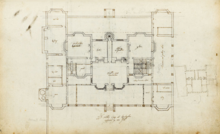
The building was of a common shape for large houses of the time,[30]containing a centre block and two porches.[31]The building received a large expansion between 1625 and 1635 at the direction of the first Earl of Holland, who added two wings and arcades.[31]
The house had a Great Chamber which became known as the "Gilt Chamber". This central reception room was reworked with three stone arches provided by the master masonNicholas Stonein 1632.[32]The decoration is often attributed to the German-born artistFrancis Cleyn,[33][34]but documentation shows the decorator was Rowland Bucket.[35]The scheme included "figures over the fireplace were painted in flesh colour wherever bare; the rest was in shaded gold. The lower marbles of the fireplace were black, and the upper ones were Sienna; the capitals and bases of the columns and pilasters were gilt, and the groundwork from which all the glittering decoration rose was white."[36]It carried decorations of thecoats of armsof the Cope and Rich families. Rowland Bucket also provided carved and gilded chairs for the room, thought to be in Italianate style, and Cleyn may have designed these and other carved features for Bucket.[37]Later, numerousbustswere displayed in niches in the gilt chamber, many byJoseph Nollekens,with subjects including the first Lord Holland,Prince William, Duke of Cumberland,Francis Russell, 5th Duke of Bedford,Gaspar Melchor de Jovellanos,Napoleon,the Italian poetLudovico Ariosto,Henry IV of France,King George IV,and Charles James Fox. Portraits in the room included the Lennox, Digby, and Fox families, and a portrait bySir Joshua Reynoldsof Charles James Fox as a boy with his first cousin Lady Susan Strangways and his auntLady Sarah Lennox.[g]

Holland bought tapestry from theMortlake Worksfor his new rooms. As a retreat from the heat of summer, there was a basement grotto, possibly the work ofNicholas Stonein the 1630s.[39]Holland began a second campaign of building in 1637 with a new west wing (demolished in 1702) with grand stables and a coach house. These works may have been designed byIsaac de Caus.[40]

In 1629, Holland commissionedInigo Jones[42]to design and the master mason Nicholas Stone to carve a pair ofPortland stonepiers, in order to support large wooden gates for the house.[h]The piers, still extant, take the form of Doric columns on pedestals, and originally supported carved griffins bearing the arms of theRich familyand Cope family, symbolising the two families' union.[45]The piers have been moved to new positions on several occasions. While their exact original position is not known, a survey in 1694 showed them as being on the drive leading to the house's main entrance on its south side. In 1848, the 4th Baron Holland moved them to the east side to be an entrance to the pleasure grounds, and on the south front created a terrace enclosed by a low balustrade. In place of the original entrance hall on the south side he created a "breakfast room".[46]Following the house's§ partial destruction in the Blitz,and the conversion in 1959 of the remains of the east wing into a youth hostel, the piers were returned to the south side.[45]

The house'sdower house,known asLittle Holland House,became the centre of a Victorian artisticsalonpresided over by thePrinsepsand the painterGeorge Frederic Watts.
In 1804 the garden of Holland House saw one of theearliest successful growths of the dahlia in England.Whilst in Madrid, Lady Holland was given either dahlia seeds or roots by botanistAntonio José Cavanilles.[47]She sent them back to England, to Lord Holland's librarian Mr Buonaiuti at Holland House, who successfully raised the plants.[48][49]
At the beginning of the 20th century, Holland House had the largest private grounds of any house in London, including Buckingham Palace.[31]TheRoyal Horticultural Societyregularly held flower shows there.
Timeline[edit]
The following timeline depicts the successive ownership of Holland House by theRich family,Edwardes family,Fox family,London County Council,Greater London Council,and finallyRoyal Borough of Kensington and Chelsea.

Galleries[edit]
-
The south frontage of Holland House
-
The China Room
-
The Dutch Garden
-
A garden with a fountain on the house's west side
-
The north side of the house viewed from its lawn
-
Steps to a garden
-
The Gilded Room, or Gilt Chamber
-
The library
-
The arcade, originally part of the old stables
-
An arcade of roses
-
The main staircase
-
The Swaneries Drawing Room
-
A garden terrace with steps on the house's east side
Notes[edit]
- ^The book of Thorpe's designs is held bySir John Soane's Museum,containing a ground-plan of the mansion with the identification "Sir Walter Coapes at Kensington, perfected per me I. T."[2]
- ^The family is commemorated in name locally byEdwardes Square,agarden squarebuilt in 1811 byWilliam Edwardes, 2nd Baron Kensingtonto the immediate south-west of Holland House.[17]
- ^TheSurvey of Kensingtonsuggests that Fox was able to pay this sum with profits obtained from his office ofPaymaster Generalduring theSeven Years' War.[3]
- ^Charles James Fox was born in 1749 at No. 9Conduit Street,while Holland House was being redecorated.
- ^The 6th Earl wrote several works on Holland House; see§ Further reading
- ^Together with its Dorset properties, the Fox-Strangways family trades as "Ilchester Estates".[29]
- ^In 1760 whilst at Eton College, Charles had developed a schoolboy crush on Susan and composed a prize-winning Latin verse describing a pigeon he found to deliver his love-letters to her "to please both Venus its mistress and him".[38]
- ^In a notebook of engraverGeorge Vertue(designated "A.b"[43]), who compiled a history of art in the country, he records "Kensington, 23 March 1629. Nicholas Stone undertakes to [make] for the Earl of Holland 2 Peeres of good Portland stone to hang a pair of great wooden gates on for£100. "[44][42]
Citations[edit]
- ^abcHistoric England 2015.
- ^Sanders 1908,p. 6.
- ^abcdefghijklmnoSheppard 1973,p. 101.
- ^abAllen 2004.
- ^Birch & Williams 1848,p. 75.
- ^Birch & Williams 1848,p. 187.
- ^Birch & Williams 1848,p. 205.
- ^Webb 1921,pp. 292–296.
- ^Thornbury 1874.
- ^Historic Royal Palaces 2012.
- ^Macaulay 1848,p. 63.
- ^Walford 1878.
- ^Faulkner 1820,p. 118.
- ^National Trust 2019.
- ^History of Parliament 1970.
- ^History of Parliament 1964.
- ^London Gardens Online 2012.
- ^Sheppard 1973,p. 127.
- ^Lascelles 1936,p. 3.
- ^abRidley 2013.
- ^Liechtenstein 1875,p.91.
- ^Greville 1887,p. 126.
- ^Robertson 1894.
- ^abcdSheppard 1973,p. 126.
- ^Page 1908.
- ^MacCarthy 2006,pp. 143–144.
- ^Mitford 2010,p. 97.
- ^Victorian Society 2013.
- ^W. A. Ellis 2012.
- ^Walford 1878,pp. 161–177.
- ^abcMitton 1903.
- ^Cooper 2020,p. 57.
- ^Fell-Smith 1909.
- ^Neale 1828.
- ^Cooper 2020,pp. 59–60.
- ^Harper's 1877,pp. 23–24.
- ^Cooper 2020,p. 60.
- ^Lascelles 1936,p. 11.
- ^Cooper 2020,pp. 62–3.
- ^Cooper 2020,pp. 63–9.
- ^Liechtenstein 1875,p. 175.
- ^abSpiers 1919,p. 8.
- ^Lindsay 1997,p. 242.
- ^Vertue 1713.
- ^abNolan & Starren 2010.
- ^Liechtenstein 1875,p. 167.
- ^Forbes & Russell Bedford 1833,p. 246.
- ^Hogg 1853,p. 5.
- ^Salisbury 1808,p. 93.
References[edit]
Biographies[edit]
- Allen, Elizabeth (23 September 2004)."Cope, Sir Walter (1553?–1614)".Oxford Dictionary of National Biography(online ed.). Oxford University Press.doi:10.1093/ref:odnb/6257.Retrieved1 June2009.(Subscription orUK public library membershiprequired.)
- Fell-Smith, Charlotte(1909).John Dee(PDF).London:Constable & Co Ltd.Retrieved27 March2019.
- Lascelles, Edward (1936).The Life of Charles James Fox.London:Oxford University Press.
- Sedgwick, Romney R.,ed. (1970)."EDWARDES, Francis (d.1725), of Johnston, nr. Haverfordwest, Pemb.".The House of Commons 1715-1754.The History of Parliament.Vol. 2: Members E–Y.Her Majesty's Stationery Office.Retrieved28 March2019.
- Namier, Lewis;Brooke, John, eds. (1964)."EDWARDES, William (c.1712-1801), of Johnston, Pemb.".The House of Commons 1754-1790.The History of Parliament.Vol. 2: Members A–J.Her Majesty's Stationery Office.Retrieved28 March2019.
- Spiers, Walter Lewis (1919). Finberg, A. J. (ed.)."Notes on the life of Nicholas Stone".The Walpole Society.7, The Note-book and Account-book of Nicholas Stone, Master Mason to James I and Charles I. Oxford:Oxford University Press.Retrieved23 October2012.
Histories[edit]
- Birch, Thomas; Williams, Robert Folkestone (1848).The Court and times of James the First: illustrated by authentic and confidential letters, from various public and private collections.Vol. 1. London: Henry Colburn.Retrieved20 October2012.
- Faulkner, Thomas (1820).History and Antiquities of Kensington.London.Retrieved27 March2019.
- Greville, Charles(1887). "Chapter XIX".The Greville Memoirs: A Journal of the Reigns of King George IV. and King William IV.Vol. 2. Forgotten Books.ISBN9781451016901.Retrieved30 August2012.
- Liechtenstein, Princess Marie(1875).Holland House(3 ed.). London: Macmillan.OL25199401M.
- Lindsay, Alexander (1997).Index of English Literary Manuscripts.Vol. 3, John Gay—Ambrose Philips. London: Mansell Publishing Ltd.ISBN0-7201-2283-X.
- Macaulay, Thomas Babington(1848). "XI".The History Of England From the Accession of James II.Vol. III.Retrieved17 September2012.
- MacCarthy, Fiona (5 October 2006).Last Curtsey: The End of the Debutantes.Faber & Faber.ISBN978-0571228591.
- Mitton, Geraldine Edith (1903). "The Kensington District". InSir Walter Besant(ed.).The Fascination of London.London: Adam & Charles Black.Retrieved17 September2012.
- Page, William, ed. (1908)."Houses of Benedictine monks: The abbey of Abbotsbury".A History of the County of Dorset.Vol. 2. Victoria County History. pp. 48–53.Retrieved28 March2019– viaBritish History Online.
- Ridley, Jane (6 April 2013)."Review: Holland House: A History of London's Most Celebrated Salon, by Linda Kelly".The Spectator.Retrieved27 March2019.
Holland's dinners kept the Whig party alive during long years of opposition, and by opening his doors to new talent and new ideas, he ensured that the party didn't stand still.
- Sanders, Lloyd Charles (1908).The Holland House Circle.London:Methuen & Co.Retrieved1 December2012.
- Sheppard, F. H. W., ed. (1973).Northern Kensington.Survey of London.Vol. 37. London:British History Online.Retrieved25 May2024.
- Thornbury, George Walter(1874).Old and New London: a Narrative of its History, its People, and its Places.
- Walford, Edward (1878). "Holland House, and its Historical Associations".Old and New London.Vol. 5.British History Online.Retrieved12 December2012.
- Webb, E. A. (1921). "The parish: Descendants of Rich and the advowson".The records of St. Bartholomew's priory [and] St. Bartholomew the Great, West Smithfield.Vol. 2.Retrieved31 August2012.
Art and architecture[edit]
- "Elizabethan and later English furniture".Harper's New Monthly Magazine.56(331). New York:Harper & Brothers:22. December 1877.Retrieved28 March2019.
- Cooper, Nicholas (30 December 2020)."Holland House: Architecture in an Elite Society".Architectural History.63.Cambridge University Press:37–75.doi:10.1017/arh.2020.2.S2CID229716135.Retrieved7 April2022.
- Historic England."Holland House (1267135)".National Heritage List for England.Retrieved9 July2015.
- "Origins: From Jacobean mansion to Kensington Palace".Historic Royal Palaces.2012.Retrieved13 December2012.
- "Edwardes Square".London Gardens Online. Archived fromthe originalon 19 April 2016.Retrieved4 February2016.
- "Charlotte Myddelton, Countess of Warwick (1680-1731)".National Trust.2019.Retrieved25 March2019.
- Neale, John Preston (1828)."Holland House, Middlesex".Views of the Seats of Noblemen and Gentlemen, in England, Wales, Scotland, and Ireland.Vol. 4.
- Nolan, David; Starren, Caroline (2010)."On Public View: A journey around the sculpture of the Royal Borough of Kensington and Chelsea"(PDF).Royal Borough of Kensington and Chelsea.Retrieved17 September2012.
- Robertson, John Ross(1894)."3: The History of Holland House".Robertson's Landmarks of Toronto.Robertson's Landmarks of Toronto Revisited. Archived fromthe originalon 28 March 2019.Retrieved28 March2019.
- "Listed buildings".The Victorian Society.Archived fromthe originalon 7 December 2009.Retrieved16 February2013.
- Vertue, George(1713).Common-place books of G. Vertue.Vol. 2. Add MS 23068-23074.Retrieved23 October2012.
Other works[edit]
- Forbes, James;Russell Bedford, John(1833).Hortus Woburnensis, A Descriptive Catalogue of upwards of Six Thousand Ornamental Plants Cultivated at Woburn Abbey.J. Ridgway.
- Salisbury, R. A. (5 April 1808). "Observations on the different Species of Dahlia, and the best Method of Cultivating them in Britain".Transactions of the Horticultural Society of London.1.London: W. Bulmer & Co.
- Hogg, Robert(1853).The Dahlia; Its History and Cultivation.Groombidge and Sons.
- "Ilchester Estates".W. A. Ellis Estate Agents. 2012. Archived fromthe originalon 11 October 2018.Retrieved18 November2018.
- Mitford, Deborah (9 November 2010).Wait for Me!: Memoirs.Farrar, Straus and Giroux.ISBN978-0374207687.
Further reading[edit]
- Giles Fox-Strangways, 6th Earl of Ilchester:
- The House of the Hollands 1605-1820,London, 1937
- Chronicles of Holland House,1820–1900, London, 1937
- Catalogue of pictures belonging to the Earl of Ilchester at Holland House,London, 1904
External links[edit]
- Media
- Map of the buildingArchived23 September 2016 at theWayback Machine(PDF) byOrdnance Surveyfor the house's entry inHistoric England's list of buildings
- Archive filmfromPathé Newsshowing the ruins of Holland House after its destruction in the Blitz.
- Alternative versions of the photograph of people looking at books in the ruined library:1,2
- Photos from 1952, when the house was sold to the Royal Borough of Kensington and Chelsea, showingthe damaged interior of the house,andworkers clearing rubble.
- Photographic gallery of the current appearance of the building
- Websites
- Buildings and structures in the United Kingdom destroyed during World War II
- Country houses in London
- Former castles in England
- Former houses in the Royal Borough of Kensington and Chelsea
- History of the Royal Borough of Kensington and Chelsea
- Fox family (English aristocracy)
- Grade I listed houses in London
- Holland Park
- Houses completed in 1605
- Rich family
- Youth hostels in England and Wales
- 17th-century architecture in England
- 1605 establishments in England
- Buildings and structures demolished in 1940
- 1940 disestablishments in England
- James VI and I
- Charles I of England
- Oliver Cromwell
- William III of England






